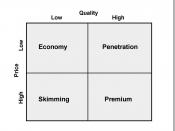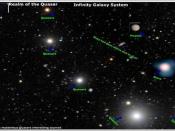Simulation OverviewCredited with launching the world's first all optical notebook, Quasar Computers has branded their revolutionary wonder, the 'Neutron', a good choice due to speed capabilities five times the current conventional micro-chip processor. Quasar also enjoys a monopoly granted, by patent rights in 2003, for three years. (University of Phoenix, 2009) This paper will explore strategic variables best suited to sustain company profits through the years of monopoly and thereafter, as market structure changes.
Solution to Sustain ProfitsQuasar needs to decide on a launch price for Neutron and monopoly indicates the best strategy is MC = MR rule. A price of $2,550 is where total profit equals 1.29($bn). With no suitable substitutes, advertising is a key decision throughout the coming year of 2004. $400 million budgeted at 2003 launch is increased to $600 million for 2004, investing in brand building. (University of Phoenix, 2009)Pricing Strategies - 2004The strategic move for profit maximization is reducing price to $2,450, where MC = MR.
Successful advertising campaigns are targeted at large corporations. Price reduction to $2,450 is optimal for 2004. Large increases in sales volume, generates a total profit of 2.74($bn). Non-Pricing Strategies - 2005Quasar production efficiency has come up. After a successful pricing and advertising campaign, now's the time to improve manufacturing processes, reducing production costs. A comfortable revenue stream from increased demand has generated the need for increased output. The decision is made to invest in upgrading production processes for 2005. Price set at $2,200 reflects total profit of 2.21($bn). Quasar still enjoys a monopoly and can set price for Neutron higher. Keen management realizes the patent will expire soon and with a downward sloping demand curve, an increase in price will result in decreased demand (McConnell & Brue, 2004). Investment in advertising for brand confirmation, while improve productivity,


